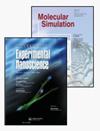Effect of endohedral nickel atoms on the hydrophilicity of carbon nanotubes
IF 2
4区 化学
Q4 CHEMISTRY, PHYSICAL
引用次数: 0
Abstract
ABSTRACT Carbon nanotubes (CNTs) have been successfully used in biomedicine, including cancer therapy, due to their unique physico-chemical properties. Because pristine CNTs exhibit hydrophobic behaviour, they can have a cytotoxic effect on cells, which limits their practical use in biomedicine. The toxicity of CNTs can be reduced by adding water-soluble functional radicals to their surface, i.e. by increasing their hydrophilicity. Another possibility for increasing the hydrophilicity of CNTs is probably filling them with endohedral metal atoms, which has not yet been studied. Thus, in this study, we use computer simulations to investigate the combined effect of endohedral nickel atoms and functional groups on the hydrophilicity of CNTs. Our simulation results show that the introduction of endohedral nickel atoms into CNTs increases their binding energy with functional groups. We also find that the addition of functional groups to the surface of CNT, along with filling it with endohedral nickel atoms, leads to an increase in the dipole moment of the CNT as well as its interaction energy with water, thereby increasing the hydrophilicity of the CNT and, consequently, its solubility in water. This, in turn, can lead to a decrease in CNT toxicity.镍原子对碳纳米管亲水性的影响
碳纳米管(CNTs)由于其独特的物理化学性质,已成功地应用于生物医学,包括癌症治疗。由于原始碳纳米管表现出疏水行为,它们可能对细胞具有细胞毒性作用,这限制了它们在生物医学中的实际应用。通过在其表面添加水溶性功能自由基,即增加其亲水性,可以降低碳纳米管的毒性。增加碳纳米管亲水性的另一种可能性可能是在碳纳米管中填充内嵌金属原子,这一点尚未得到研究。因此,在本研究中,我们使用计算机模拟来研究内嵌镍原子和官能团对CNTs亲水性的联合影响。我们的模拟结果表明,在碳纳米管中引入内嵌镍原子增加了碳纳米管与官能团的结合能。我们还发现,在碳纳米管表面添加官能团,以及用内嵌镍原子填充碳纳米管,会增加碳纳米管的偶极矩以及与水的相互作用能,从而增加碳纳米管的亲水性,从而提高其在水中的溶解度。这反过来又可以导致碳纳米管毒性的降低。
本文章由计算机程序翻译,如有差异,请以英文原文为准。
求助全文
约1分钟内获得全文
求助全文
来源期刊

Molecular Simulation
化学-物理:原子、分子和化学物理
CiteScore
3.80
自引率
9.50%
发文量
128
审稿时长
3.1 months
期刊介绍:
Molecular Simulation covers all aspects of research related to, or of importance to, molecular modelling and simulation.
Molecular Simulation brings together the most significant papers concerned with applications of simulation methods, and original contributions to the development of simulation methodology from biology, biochemistry, chemistry, engineering, materials science, medicine and physics.
The aim is to provide a forum in which cross fertilization between application areas, methodologies, disciplines, as well as academic and industrial researchers can take place and new developments can be encouraged.
Molecular Simulation is of interest to all researchers using or developing simulation methods based on statistical mechanics/quantum mechanics. This includes molecular dynamics (MD, AIMD), Monte Carlo, ab initio methods related to simulation, multiscale and coarse graining methods.
 求助内容:
求助内容: 应助结果提醒方式:
应助结果提醒方式:


